Thursday, January 14:
- Governor Andrew Cuomo announced in his annual State of the State speech that the New York will phase out its dirtiest power plants, adopting renewable power. He said clean energy is a business opportunity for the state, as well as an important step to address increasing climate challenges. [Capital New York]

New York City’s first commercial-scale wind turbine at the Sims
Material Recovery Facility. (AP Photo/Bebeto Matthews)
- Oil prices briefly have fallen below $30 a barrel on international markets for the first time since April 2004, before recovering again. Brent crude, used as an international benchmark, fell as low as $29.96, but bounced back to trade at $30.22. Oil prices have fallen by 70% in the past 15 months. [BBC]
- Global clean energy investment in 2015 rose to the record-high $329.3 billion (€303 billion). A report by Bloomberg New Energy Finance shows record investments despite falling fossil fuel commodity prices, weakness of the European economy, and the increasing capacity per investment dollar of PVs. [SeeNews Renewables]
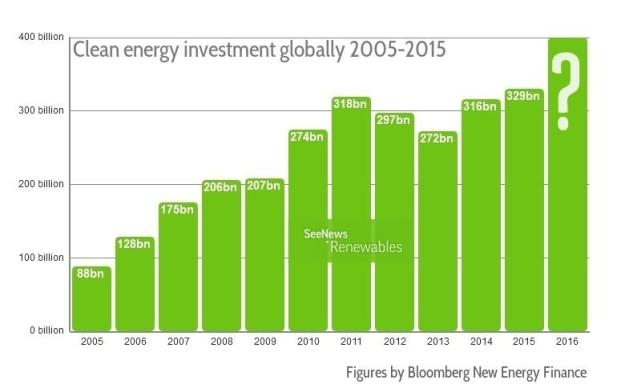
Clean energy investment globally 2005-2015. Figures by BNEF.
- The US has seen coal production levels fall to their lowest levels since 1986, dropping 10% in 2015 alone. Production in the Appalachian Basin fell the most last year. Lower natural gas prices and lower international demand for American coal are said to be behind the declining coal production. [CleanTechnica]
Friday, January 15:
- SunEdison announced it has signed solar power purchase agreements with 25 California elementary, middle, and high schools. SunEdison plans to install high-performance solar parking canopies at each of their campuses. The schools expect to save more than $30 million over the next 20 years. [IT Business Net]
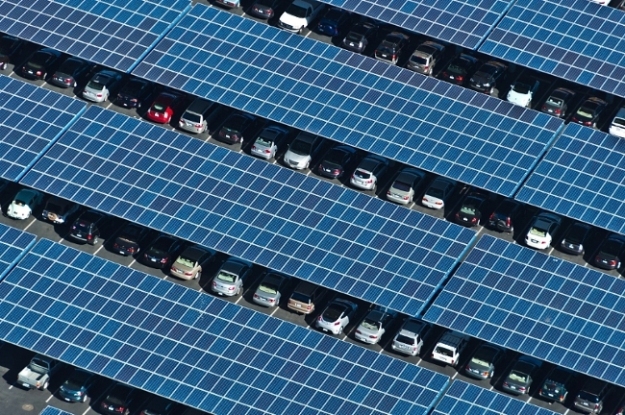
Aston Field Solar Plant by Stausifr
via Wikimedia Commons (Some Rights Reserved)
- US utility-scale solar PV costs plummeted 17% in Q3 of 2015, and declining PV costs are fuelling greater demand. According to an EnergyTrend report, US utility-scale solar costs fell in the third quarter of 2015 to $1.38/W, compared to $1.66/W twelve months earlier. Further drops are expected. [CleanTechnica]
- Wind power in Denmark met 42.1% of national consumption in 2015 and the figure would have been even higher if not for cable issues at the 400-MW Anholt and 209-MW Horns Rev 2 offshore wind farms. This represents an increase of over 2014’s 39.1% share and is a new record for the country. [SeeNews Renewables]
Saturday, January 16:
- In a piece published on its website this week, the UK Solar Trade Association made it clear it believes that residential solar remains a good investment for householders, despite Government’s backsliding on their green policies, and in the wake of the recent modifications to the country’s Feed-in Tariff. [CleanTechnica]
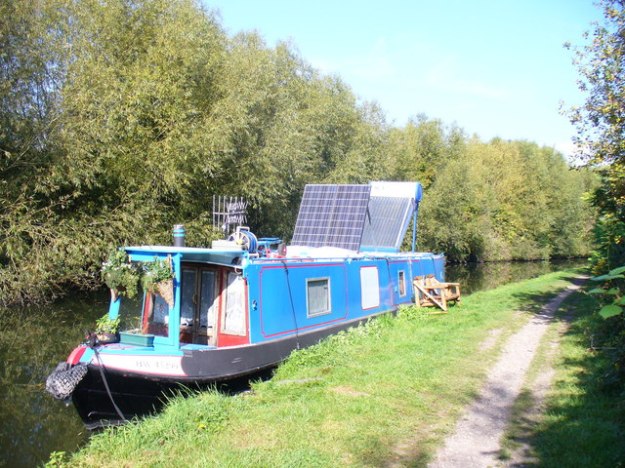
Solar Power on a narrowboat on the Grand Union Canal in Hertfordshire. Photo by Colin Smith. CC BY-SA 2.0 Generic. Wikimedia Commons.
- The Venezuelan government announced a 60-day economic emergency to deal with a crisis brought on by the huge fall in oil prices in the past 18 months, which slashed its revenues by 60%. The country has the world’s biggest known oil reserves, and oil exports account for as much as 95% of its revenue. [BBC]
- The Obama administration announced on Friday that it will suspend new coal leasing on federal lands and overhaul the program to better reflect environmental costs. This could be a turning point in climate policy. It is a concrete measure toward leaving fossil fuels in the ground, as the science demands. [InsideClimate News]
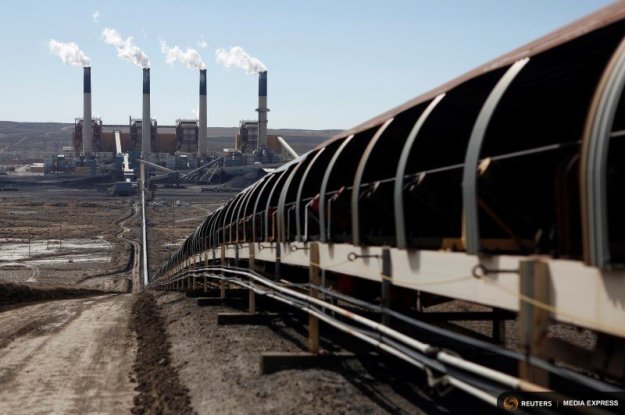
Coal is conveyed to a power plant in Wyoming. Credit: Reuters
Sunday, January 17:
- In 2009, Navy Secretary Ray Mabus announced that the Navy and Marine Corps would get half of their power from non-fossil fuel sources by 2020, and that the Navy would deploy an entire carrier strike group with biofuels replacing fossil fuels by 2016. Now, the “Great Green Fleet” is ready to deploy. [The San Diego Union-Tribune]

Ships from the John C. Stennis Carrier Strike Group are underway
in the western Pacific Ocean. Petty Officer 3rd Class Walter W
- According to a report published by the International Renewable Energy Agency, Renewable Energy Benefits: Measuring the Economics, increasing the global share of renewable energy to 36% by 2030 would increase global gross domestic product by up to 1.1%. This means about $1.3 trillion. [CleanTechnica]
Monday, January 18:
- Oil prices fell below $28 a barrel amid fears the lifting of Western sanctions on Iran could increase the oversupply. Brent crude, used as an international benchmark, fell as low as $27.67 a barrel, its lowest since 2003, before recovering slightly to trade at $28.17. The price of US crude fell to $28.86. [BBC]
- The North African country of Morocco has achieved a new low for wind energy costs, securing average bids of just $30/MWh from its tender for 850 MW tender of large-scale wind energy projects, with the lowest at around $25/MWh. Until recently, Morocco sourced all its energy needs from fossil fuels. [RenewEconomy]
- In its first year of operation, the so-named Shams 1 plant in Abu Dhabi beat expectations by a wide margin, and its second year figures are also better than predicted. The concentrating solar plant has a nameplate capacity of 100 MW, but in peak summer days during 2015, it often produced 125 MW. [CleanTechnica]

Photo by Tina Casey

Panoramic view at Abu Dhabi
Tuesday, January 19:
- Germany connected a record 2,282.4 MW of offshore wind capacity to the grid in 2015. Just 492.2 MW was installed in 2014, and the industry expects about 700 MW for 2016. At the end of 2014, 1,345 MW were fully installed in German waters and awaited grid connection due to delays. [SeeNews Renewables]
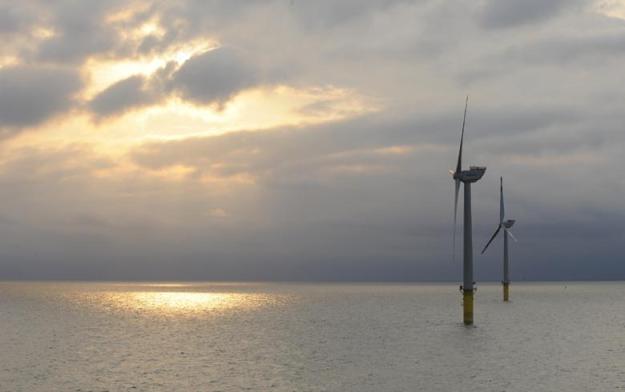
Adwen turbines at Alpha Ventus wind farm in the German North Sea. Copyright: Adwen GmbH / J. Oelker.
- China’s gross domestic product grew 6.9% in 2015 from a year earlier, the least growth since 1990, according to government figures. Power consumption rose 0.5%, slowing from a 3.8% advance the previous year. Coal imports fell about 30% last year, and approval of new mines may be suspended this year. [Bloomberg]
Wednesday, January 20:
- Carbon capture and sequestration is expensive because each step, capture, distribution, and sequestration, is expensive. According to an organization which promotes carbon capture and sequestration, it will cost $120-$140 per ton of CO2. This means 16.8¢/kWh to 19.6¢/kWh extra for electricity. [CleanTechnica]
- China’s emissions of carbon dioxide produced as a result of using coal for electricity generation probably fell 2% in 2015, as a push by the world’s most populous nation to tackle climate change resulted in less of the fuel being burned. Carbon emissions were reduced by 144.9 million metric tons. [Bloomberg]
- Green Mountain Power announced today the year-end operational results for Kingdom Community Wind in Lowell. In 2015, the 21-turbine project generated enough electricity to power 26,700 homes for a year. That’s an increase of 7% over the previous year or enough energy to power an additional 1,800 homes. [Vermont Biz]
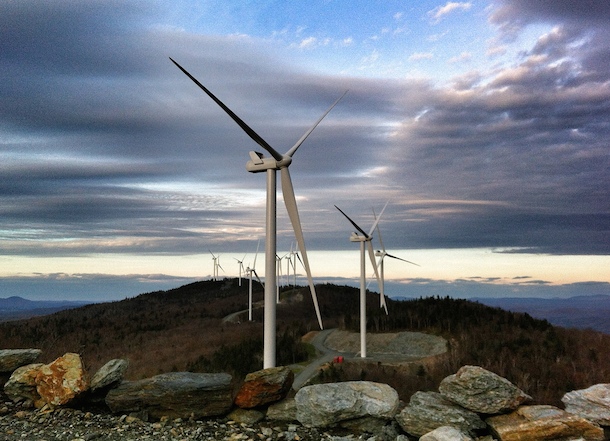
Kingdom Community Wind. Green Mountain Power photo.